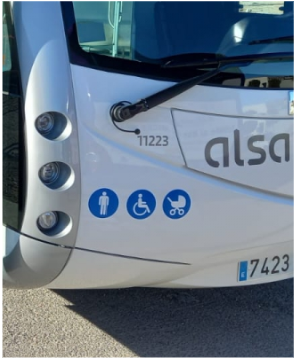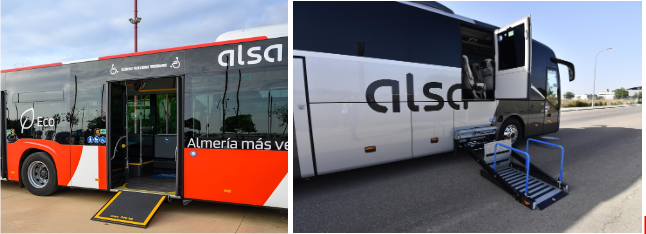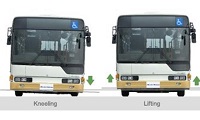Equipment on our fleet
We are constantly incorporating innovative equipment and features in our buses in order to guarantee universal accessibility for all users.
In general, our urban and metropolitan service vehicles are equipped with:
Virtually all of our urban vehicles are low entry or have a completely low floor, which facilitates passenger access and their movement inside the vehicle.

Exterior signage denoting the corresponding accessibility standard.

Exterior button for requesting access ramp/platform.
Our vehicles have an electric ramp/platform for wheelchair access, generally located at the central door, to facilitate access to the bus for passengers in wheelchairs/scooters.
This automatic ramp/platform only operates when the vehicle is stationary and the parking brake is engaged.
In all cases, the folding and unfolding movements are accompanied by visual and audible warning signals, both inside and outside of the vehicle. The ramp/platform should not be used until it is fully in place, i.e., when the flashing lights and sounds stop.
In these urban vehicles, the access device consists of a horizontal ramp protected by a safety device, which prevents the ramp from moving when it detects an obstacle. Furthermore, in the event of a breakdown, the majority of our ramps can be easily extended and retracted manually to ensure access.

In the case of metropolitan vehicles, depending on the model, they will have a ramp similar to the one described above or a lifting platform similar to that of intercity vehicles.
In the case of the latter, these are 100% automatic lifting platforms equipped with an electrical protection mechanism, side protection bars and front and rear folding covers to facilitate boarding and prevent possible falls.
Consult the minimum requirements for wheelchairs and scooters to be permitted.
Seat-free space for wheelchair or scooter users, near the central door to facilitate passenger access, as this door is where the access ramp/platform is normally located.
This space is signposted for preferential use by wheelchair users and is equipped with a seat belt and a support board.
The passenger must travel rearward-facing, making use of the aforementioned support and the seat belt.
Specific stop buttons for passengers sitting in these spaces.
These seats are preferably located near the doors of the vehicle and near to the space for PRM in wheelchairs to facilitate access to passengers with reduced mobility or disabilities.
They are identifiable as they are a different colour to the other seats and are accompanied by specific pictograms, and they offer more space to facilitate accessibility and even to accommodate an assistance dog if necessary.
Specific stop buttons for passengers sitting in these seats.
Full set of bars and handles in contrasting colours and non-slip material to facilitate access and transit inside and when exiting the bus.
You will find them on all access steps, luggage racks, seats and on the inside of the exit doors.
To guide people with reduced visibility from outside the entrance door to their reserved seating, and also to the ticket validation machines, our buses are equipped with several optical-acoustic positioning elements, such as:
- Overhead warning light at the entrance door with beeper/speaker, which emits intermittent flashes of light and sounds to help passengers locate the entrance door.
- Warning lights on the front door and under the ticket vending and validating machines.
- Lastly, the handrails are equipped with markers that indicate the location of seats reserved for passengers with reduced mobility (PRM).
Standardised, easy-to-understand pictograms distributed throughout the vehicle, in addition to Braille signage.

Located on the ceiling, behind the driver’s seat or in the middle of the vehicle, or sometimes in both locations, this is an opaque glass sign which separately provides the messages “STOP REQUESTED” and “RAMP REQUESTED”, with an acoustic warning when activated by a passenger and alerting the driver on the dashboard.
State-of-the-art anti-slip flooring with non-reflective materials, when both wet and dry.
The edges of steps up to the bus and inside the bus are in a contrasting colour, generally in yellow or a reflective material.
Anti-trap system at doors that reverses the opening/closing process in the event of an obstacle.
A locking system that prevents the vehicle from moving when a door is open or the ramp/access platform is deployed.
A kneeling system that lowers the vehicle on the right-hand side to facilitate access to passengers with disabilities or reduced mobility.

The vehicles have operating assistance systems (OAS) that provide information by public address and visual information outside the bus, indicating stops, service information and the destination.
Some services also have magnetic induction loops that allow passengers to listen to service-related messages on their own implants or hearing aids.
 Español
Español
 Català
Català
 Français
Français
 Galego
Galego
 Italiano
Italiano
 Portugues
Portugues
 Euskara
Euskara
 Deutsch
Deutsch
